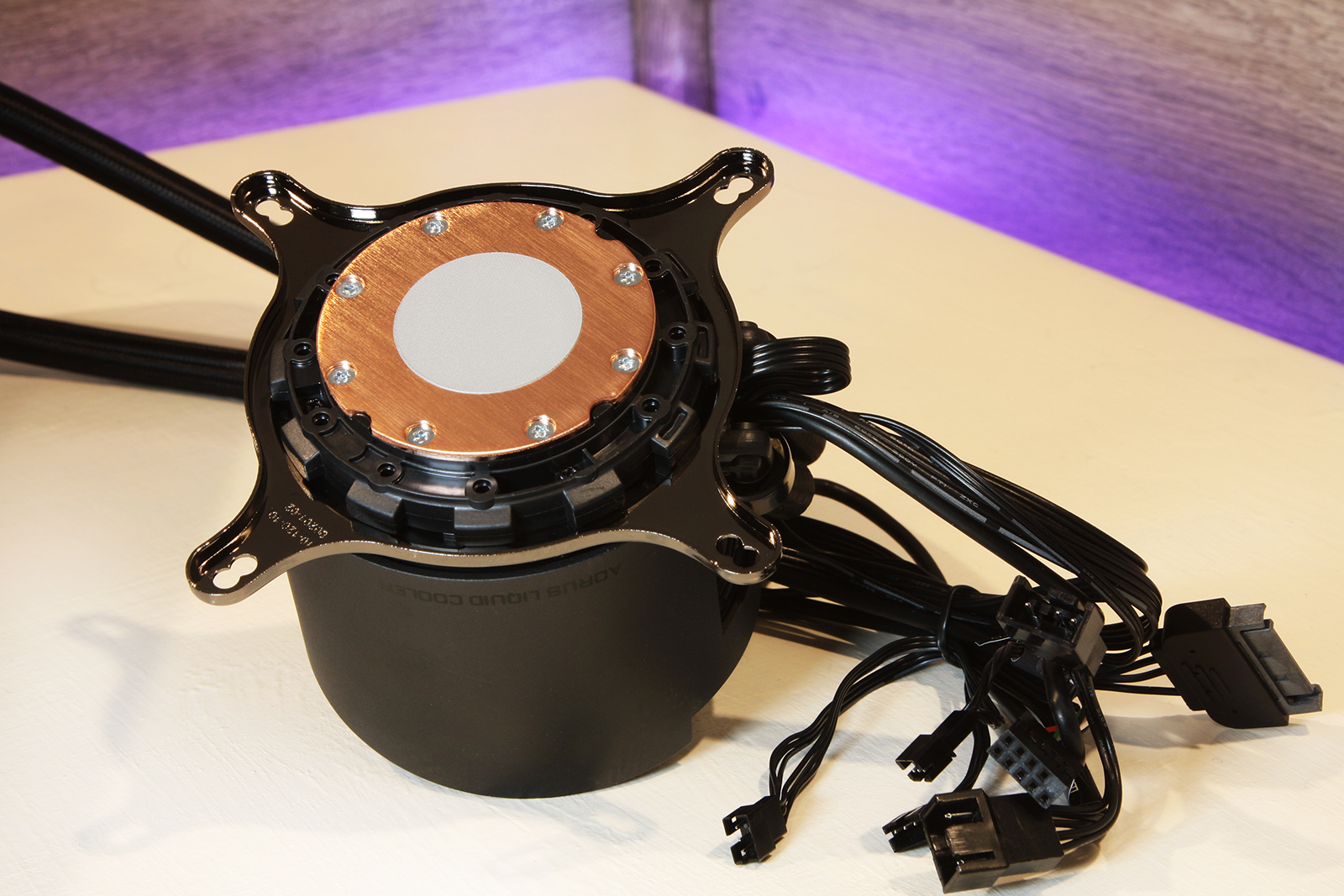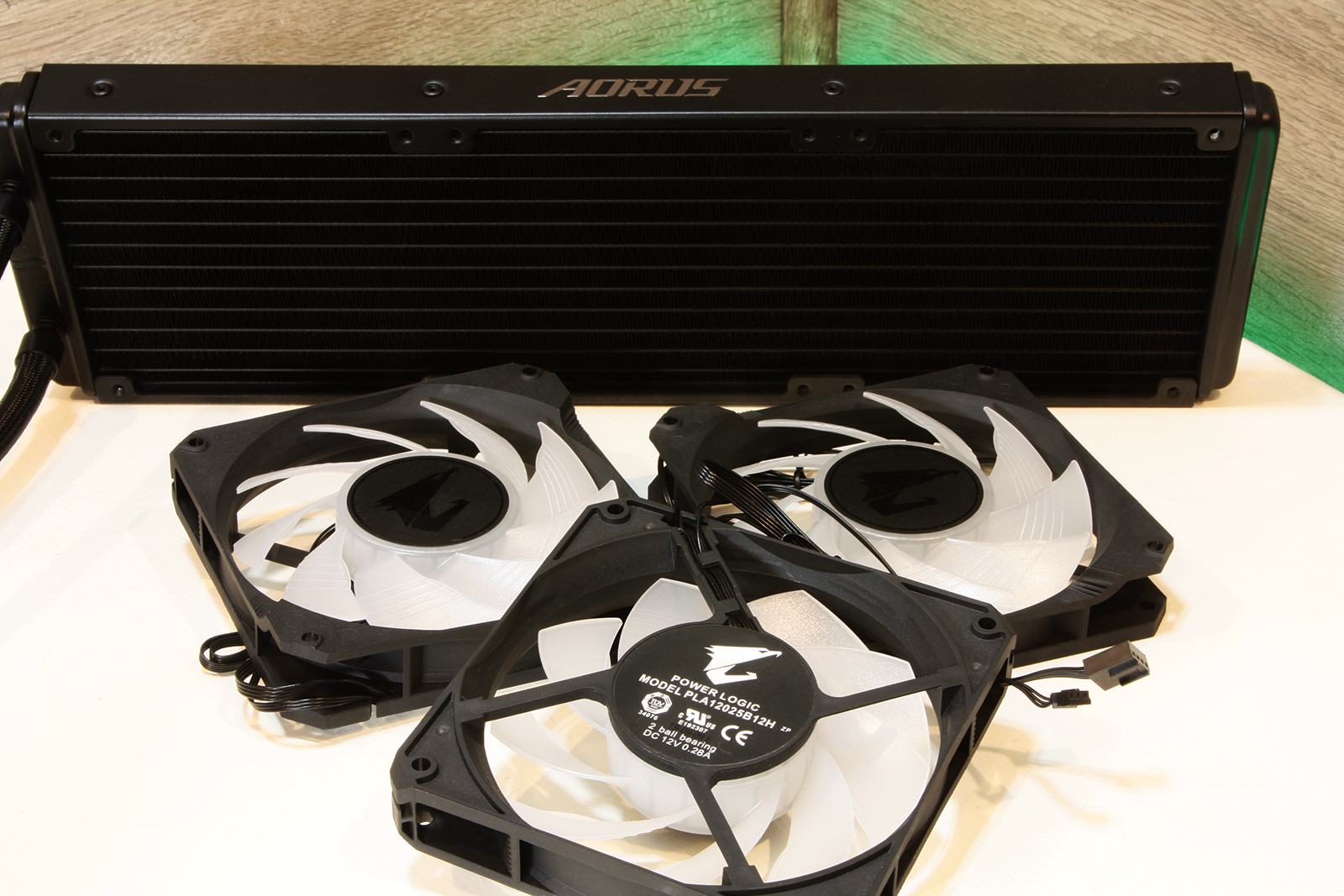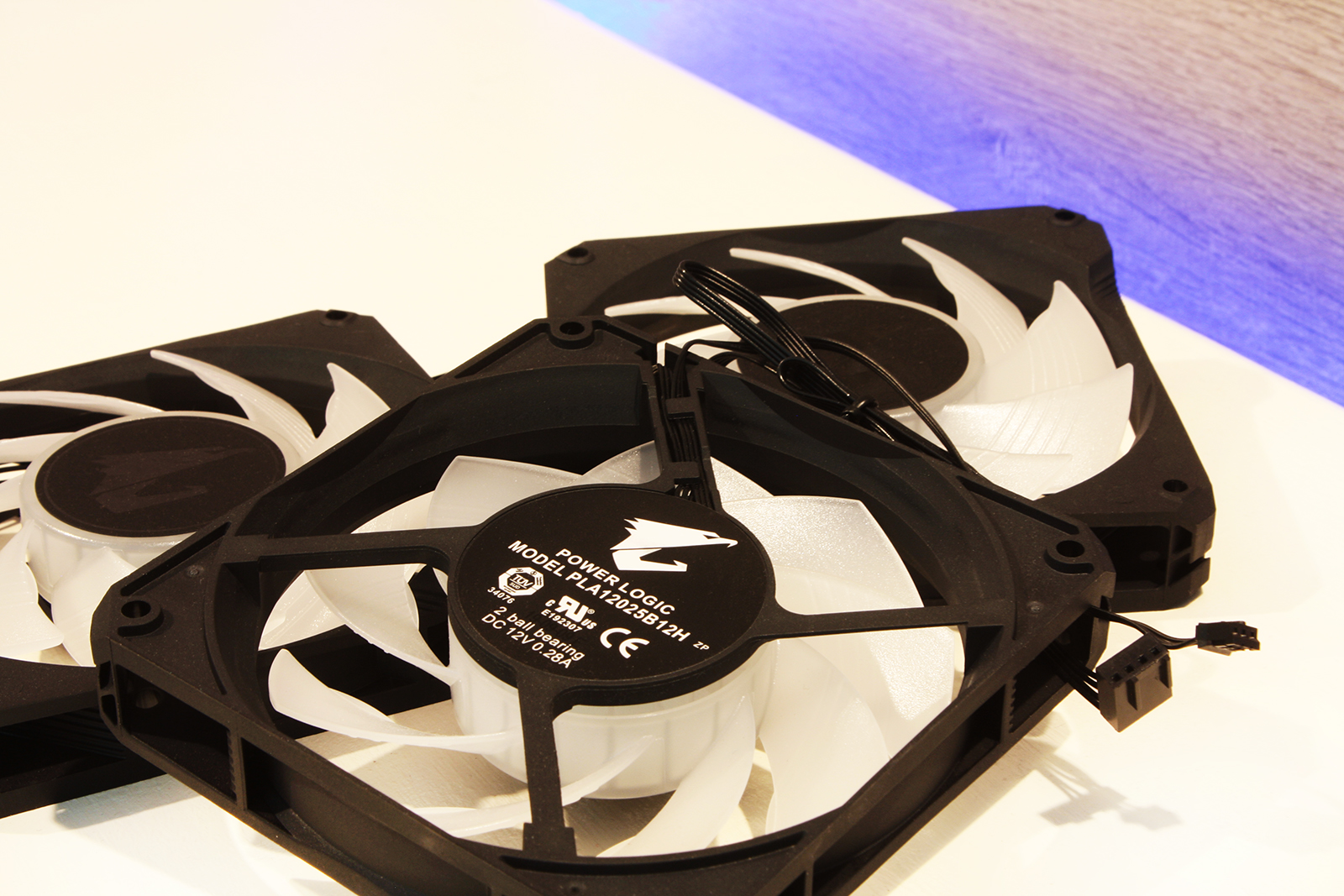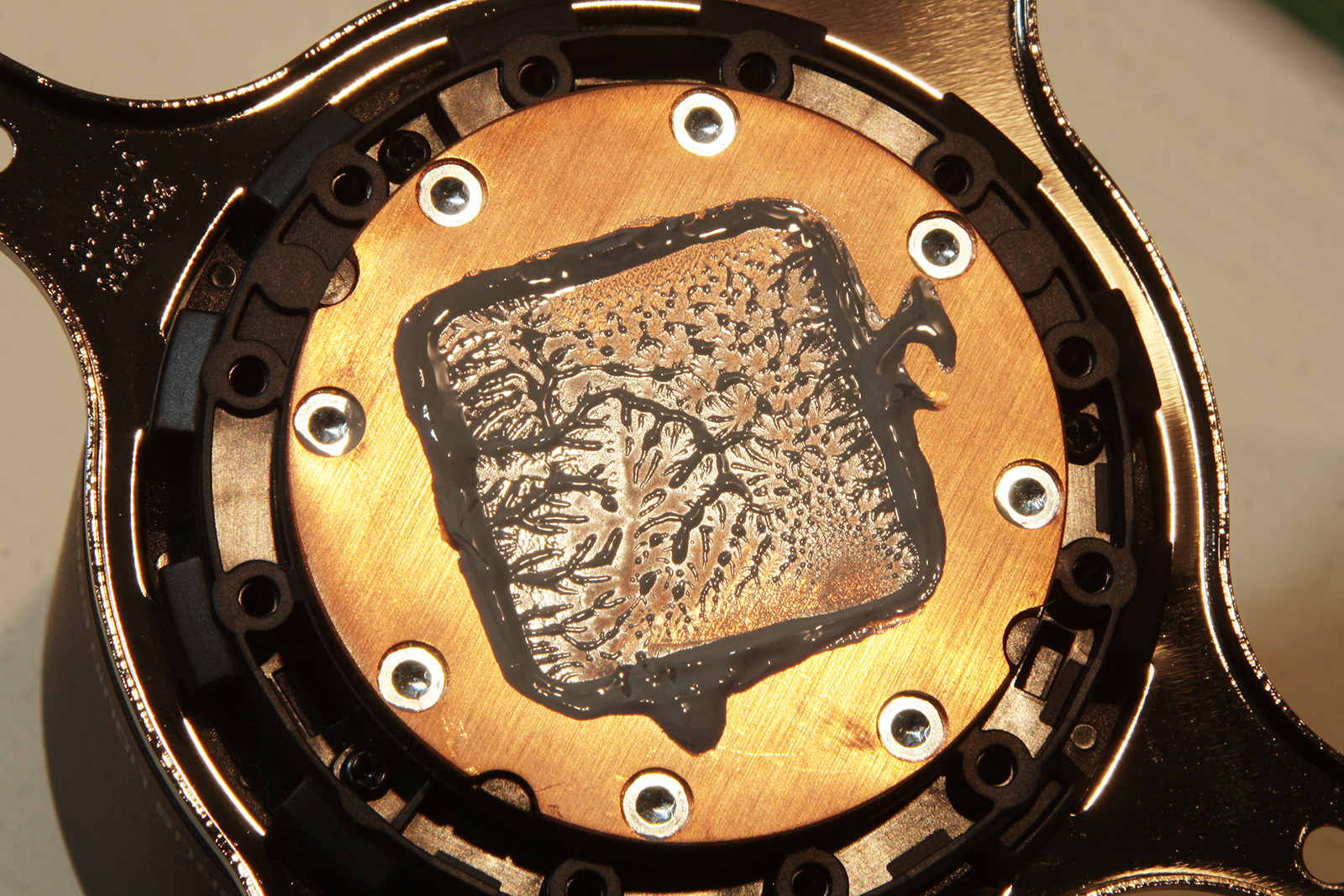Tom's Hardware Verdict
The Aorus Liquid Cooler 360 offers solid overall cooling performance, lower noise levels and a handsome 60mm LCD face with customizable display options. But a premium price and the need to manage a pair of software applications won't appeal to everyone.
Pros
- +
Very nice LCD display
- +
Strong cooling performance
- +
Quieter operation than competition
Cons
- -
Requires two applications to manage lighting, PWM curves and custom LCD image
- -
Expensive
Why you can trust Tom's Hardware
Gigabyte’s Aorus line of products have always leaned heavily on RGB lighting and aesthetics, while still aiming to deliver the pinnacle of PC performance. And as the brands pinnacle CPU AIO cooling option, the Aorus Liquid Cooler 360 aligns with this vision, bringing good cooling performance in a quiet package with a flashy customizable LCD screen atop the pump. It's not cheap at $265, but those willing to pay extra for some internal flair without sacrificing performance should find it appealing. Just be aware that managing the pump, fans and the screen requires some software juggling.
Aorus Liquid Cooler 360 Specifications
| Thickness | 1.125" / 28.6mm (2.25" / 57.15mm w/fans) |
| Width | 4.75" / 120mm |
| Depth | 15.5" / 393.7mm |
| Pump Height | 3.0" / 76.2mm |
| Speed Controller | BIOS/Software |
| Cooling Fans | (3) 120 x 25mm |
| Connectors | (3) 4-Pin PWM, (3) 3-Pin aRGB, (1) SATA, (1) 9-pin USB |
| Weight | 48.5 oz / 1376g |
| Intel Sockets | 115x, 1200, 2011x, 2066 |
| AMD Sockets | AM4, TR4 |
| Warranty | 3 years |
| Web Price | $265 |
The Aorus Liquid Cooler 360 ships with mounting hardware for most common Intel CPU sockets as well as AMD’s AM4 and Threadripper, making use of interchangeable mounting brackets and a universal backplate. A large syringe of Aorus-branded thermal compound is also included, even though the Aorus 360 also comes with a pre-applied patch on the copper baseplate.
The Aurus Liquid Cooler 360 is covered by a 3-year Gigabyte warranty.
The Aorus 360 encases the pump unit within an aluminum housing, capped with an offset face ring, resting atop a 60mm LCD display. Tubing makes its way in and out of the pump by means of a pair of rotating, 90° fittings, while the tubing is fully sleeved with braided black nylon.
Providing power to the Aorus Liquid Cooler 360 via 12v SATA brings the pump and 60mm LCD to life. The active display is managed via software UI from the 9-pin USB motherboard header and displays system statistics, animated graphics and custom images as chosen from the Aorus Engine and RGB Fusion software.
The Aorus Engine app can be used for the Aorus Liquid Cooler 360’s desktop software control for pump and fan RPM control via configured curves, as well allowing some customization for text and display data.
For example, when setting up our ‘Toms Hardware’ custom text, we had to define text within the Aorus Engine UI. But then to apply the text and color scheme we had to launch the RGB Fusion UI to adjust, select and apply the text.
Get Tom's Hardware's best news and in-depth reviews, straight to your inbox.
One thing to note is that the apostrophe (as well as some other characters) do not seem to be a viable for use in the Aorus software UI, while the lack of integration between Aorus Engine and RGB Fusion software solutions creates a bit of disorganization and disjointed software management compared with other AIO solutions.
The base of the Aorus 360 features a ringed-tooth retention system for the interchangeable mounting plates. and the copper base plate comes with a pre-applied patch of thermal compound.
While the pump unit of the Aorus Liquid Cooler 360 acts as a centralized management hub for the cooler and its fans, this also requires a bit of spaghetti cabling in order to do so. SATA power, aRGB splitter, PWM headers and 9-pin USB must have cabling extend from the side of the pump housing. So get ready to do some creative cable routing / hiding.
The Aorus Liquid Cooler 360 utilizes a common 360mm aluminum radiator, similar to most other large AIOs.
The Power Logic 120mm dual ball bearing fans used by the Aorus 360 are rated up to 2500 RPM and 59.25 CFM. Fan speed control is available via 4-pin PWM headers while aRGB 3-pin (5v) lighting is interfaced through Aorus' custom socket control.
The base of the Aorus Liquid Cooler 360 is very evenly milled and does not show any backlighting peeking between the copper plate and a steel rule. This should allow for neutral CPU IHS mating during cooler mounting.
The Aorus 360 does, in fact, mount really well on our Intel Core i9-10850K and shows even dispersal of Arctic MX-4 thermal compound after proper tensioning, thermal break-in and load testing.
The mounting system of the Aorus 360 uses the common 4-post mounting offsets, similar to most other AIOs, with a set of knurled, Phillips head thumbscrews.
While the 90-degree fittings and all cabling are located in the same location, the combination of all wiring and tubing will certainly require extra cable management.
Installation of the Aorus Liquid Cooler 360 requires support for 360mm radiators, but is easily installed if your case supports coolers of this size.

Garrett Carver is a contributor for Tom’s Hardware, primarily covering thermal compound comparisons and CPU cooling reviews; both air and liquid, including multiple variations of each.
-
Erik_1 ReplyAdmin said:The Aorus Liquid Cooler 360 delivers good cooling performance in a quiet package with a flashy customizable LCD screen atop the pump.
Aorus Liquid Cooler 360 Review : Read more
I owned the 240 version of this cooler, and the software was dangerous CPU melting garbage. It was so bad that six months later I'm still angry about it. On the plus side, the cooler is cold, quiet, and pretty. If you don't mind it being completely unreliable, please buy this brand.
So, what's the problem? The problem is the fan/pump speeds are entirely software/USB controlled, and, here's the bug: If the CPU got too busy (AMD Ryzen 7 2800) ... the software would freeze, and would require restarting the Aorus software via task manager. So, I start up say Vermintide, the screen on the CPU cooler shows 28 C. I'm thinking, wow, that's fantastic! OK, 10 minutes of playing later the fan speeds are flat, the pump speed is flat, display shows 28C. Well, it's all a lie. Go looking in AMD Ryzen master, actual temp is a lot hotter. WTF?
Restart Aorus, and bam, suddenly the pump and fans spin up, and the pump display temp jumps up 25 degrees. Finally used the MSI utility CPUID and it's CPU benchmark to prove the problem was as described. I could 100% reliably hang up the fan software.
So, into the garbage it goes. Then I switched to Thermaltake, who had been super reliable for me in the past. This one had a card fluttering (air bubble) sound no amount of tilting could get rid of. That goes into the garbage too and now, many hundreds of dollars wiser, I am using a custom loop with Argus Monitor and it's silent, quiet and 100% reliable.
I should point out this was not my only software problem with the Aorus kit, I had plenty of other instances of it hanging up trying to get a custom display, rotating the display etc. and same thing would happen, the fan and pump speeds would be locked in place until the software was forcibly restarted via task manager. -
Makinen I have an Aorus extreme GTX 1080ti (remember those?) and while I love the actual build quality of the hardware and the performance three years later, I absolutely agree with the Aorus software being useless rubbish. Luckily I would only use it for rgb and I just leave it at default these days, it would crash and hang and use up all my cpu all of the time. I would not buy an Aorus product again (or Gigabyte for that matter) as apparently they have not improved one bit...Reply










